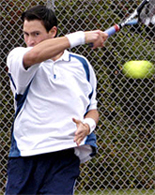Dolgopolov Slice Tactical Patterns:
Learning from a Modern Magician
Chris Lewit
Alexander Dolgopolov is the modern day Fabrice Santoro, who was affectionately known as "the magician" for his creative shot selection, particularly his use of slice. Dolgopolov probably hits more slice backhands and a greater variety of slice than any player in the game, including Roger Federer.
He has the same unpredictability and creative flair that Santoro had in his prime, along with the power and aggression required in the modern game--he's also extremely fun to watch.
Often times simply hitting change of pace slice backhands mixed with power drives is enough to induce errors from Dolgopolov's opponents. While watching Dolgopolov play, I've also observed three clear tactical patterns he favors.
These patterns apply across all ages and abilities and are something that club players in particular can implement. Many times recreational players don't have the power to blow their opponents off the court. Learning to play craftily with the slice can be an excellent addition to a club player's game, especially as they get older.
The slice is also important for high performance juniors and is an important part of the curriculum in USTA Player Development. Jose Higueras and the USTA national coaching team expect all up-and-coming American players to have a strong command of the slice, and all of the Next Gen American male and female juniors and pros have excellent slice backhands, even though some don't use the shot as much as they could.
So whether young or old, learn from the modern Magician. These patterns could be even more effective for you than for Alexander:
The Speed Change Slice
Dolgopolov loves to lull his opponents to sleep with slower balls and then surprise them with speed. For example, Dolgopolov will slow down pace with one or two slices, then power up a big forehand or backhand.
A common pattern is a slice crosscourt to the backhand followed by power shot, to the open court—a backhand down the line or a forehand inside in. Dolgopolov forces his opponent to switch grips from backhand to forehand and adjust for a change in speed of the incoming ball. This can often force an error or a weak, attackable reply that he can pounce on!
The "Watcha Gonna Do?" Slice
My favorite slice pattern is when Dolgopolov hits a short slice up the middle or slightly to the side service line, essentially daring his opponent to come to net. The shot stays low and brings the other player up to near the service line with an awkward low contact point position.
It's a win-win for Alexander. If the player chooses to come in, the attacker can't get much to attack off the low slice. If he comes in Dolgopolov has an easy pass.
If the opponent retreats, Dolgopolov plays the next ball heavy and deep, forcing the player into a defensive position and often producing a short ball he can hit for a winner.
Many times the opponent will also commit an error, either because he tried to force too good an attack shot from that low position, hesitated with indecision, or simply lost his rhythm.
What's cool about this pattern is that it's not very risky to attempt because the first target is short and straight up the middle. How often do we think of setting up our opponents with a shot to that area of the court? It's a low risk shot that places the opponent in a high risk situation.
The Side T Slice
The third pattern is what I call the Side T Slice. Often times, Dolgopolov will slice crosscourt and follow it up with a short down the line Side T slice, landing near the corner of the service line and singles sideline.
This pattern probably takes the most skill to pull off and carries a high degree of difficulty in comparison to the previous two plays. Alexander sometimes makes it look too easy.
This change of direction shot can be more effective than the deep down the line slice as it forces the opponent to run more and hit from an awkward court position. Dolgopolov also sometimes curves the slice with a little sidespin to make it extra nasty.
The opponent has limited options and the court is open. Watch in the animation as the befuddled opponent tries to hit a short crosscourt angle. Alexander finishes the point, sliding an easy forehand slice down the line for a clean winner.
If you watch much tennis, you rarely see this kind of creative variety at any level. That's one factor that makes these patterns so effective—players simply aren't used to seeing or dealing with them.
Alexander demonstrates an uncanny ability to attack his opponent with underspin and by mixing pace--a great lesson we can all learn from. If this is effective at the pro level, it has even greater potential to add a winning dimension to your own game.
Experiment with these slice patterns to disturb and disrupt your opponent like the Modern Magician. Or better yet, come up with some new slice patterns of your own.
No matter what-- try to harness the tactical principle of disturbing and disrupting your opponent, rather than simply destroying them with power. Smart use of the slice is one of the best ways to practice that principle. Learn to use the slice backhand like Alexander and your tactical game will surely grow.




